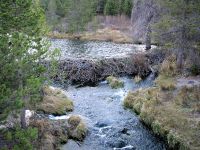Atsugewi
| Atsugewi | |||
|---|---|---|---|
| Total population | |||
| Regions with significant populations | |||
| |||
| Languages | |||
| Palaihnihan | |||
| Religions | |||
| Related ethnic groups | |||
| Achomawi, together often referred to as "Pit River Indians" |
The Atsugewi were Native Americans residing in what is now northern California, United States, in the vicinity of Mount Shasta, specifically the Pit River drainage on Burney, Hat, and Dixie Valley or Horse Creeks. They were closely related to the Achomawi, and lived to their south.
Location
The "Pit River Indians," of whom the Atsugewi are one group, traditionally occupied lands along the Pit River in the far northeastern part of California. This region, from Mount Shasta and Lassen Peak to the Warner Range, has a tremendous ecological diversity yielding a huge variety of foods, medicines, and raw materials. The Atsugewi occupied an area to the south of the Achomawi. The Atsugewi consisted of two groups (the Atsugé and the Apwaruge). The Atsugé ("pine-tree people") from the Hat Creek area, and the Apwaruge ("juniper-tree people") of the Dixie Valley. Due to their location along the Hat Creek, Atsugewi are also known as the "Hat Creek Indians."
Hat Creek rises in two forks on the eastern slopes of Lassen Peak in Lassen Volcanic National Park, and flows northward through Lassen National Forest to its mouth at Lake Britton near Burney, California. It has a trout population consisting of wild rainbow and brown trout.
Population
Estimates for the pre-contact populations of most native groups in California have varied substantially. Alfred L. Kroeber (1925:883) estimated the combined 1770 population of the Achuwawi and Atsugewi as 3,000. A more detailed analysis by Fred B. Kniffen (1928) arrived at the same figure. T. R. Garth (1978:237) estimated the Atsugewi population at a maximum of 850.
Kroeber estimated the combined population of the Achumawi and Astugewi in 1910 as 1,100. The population was given as about 500 in 1936.
History
The Atsugewi or Hat Creek people live north of Mount Lassen. The Atsugewi gave the Achumawi furs, hides, meat, seed foods, epos roots and other roots and vegetables, and got basketry caps, salmon flour, steatite, acorns, salmon, dentalia, tule baskets and rabbit-skin blankets. They gave the Northern Paiute bows, baskets and shell beads, and got horses, buckskins, red ochre, glass beads, guns and olivella beads. They gave the Northeastern Maidu bows, twined baskets, furs and horses, and got clam disc beads, coiled baskets and skins. They gave the Yana buckskin, arrows, wildcat quivers and woodpecker scalps, and got salt, dentalia, and buckeye fire drills. They traded with the Klamath of Oregon for baskets, and with the Northern Wintun (Wintu) with clam disc beads and dentalia (Davis 1966)
Culture
The Atsugewi lived by hunting and gathering, and lived in small groups without centralized political authority. They depended on fish and other river resources to survive, as well as on acorns and other vegetables growing in the river valleys.
Language
The Achumawi and Atsugewi languages are two closely related members of the Palaihnihan branch of the greater Hokan linguistic family.
Traditional narratives
Atsugewi traditional narratives include myths, legends, tales, and oral histories preserved by the Atsugewi people of the Pit River basin of northeastern California.
Atsugewi oral literature reflects the transitional position of Atsugewi culture between central California, Northwest Coast, Plateau, and Great Basin regions.
Contemporary Atsugewi
Today there are eleven bands of the Pit River Indian tribe: the Achomawi, Aporidge, Astariwawi, Atsuge, Atwamsini, Hanhawi, Hewisedawi, Ilmawi, Itsatawi, Kosalextawi, and Madesi. Today there are around 1,800 tribal members living on the Alturas, Big Bend, Big Valley, Likely, Lookout, Montgomery Creek, Redding, Roaring Creek, and Susanville rancherias, as well as on the Pit River, Round Valley and X-L Ranch reservations. Pit River Tribal Office: 37014 Main Street, Burney, CA 96013; (530) 335-5421.
ReferencesISBN links support NWE through referral fees
- Garth, T. R. 1978. "Atsugewi." In California, edited by Robert F. Heizer, pp. 236-243. Handbook of North American Indians, William C. Sturtevant, general editor, vol. 8. Smithsonian Institution, Washington, D.C.
- Kniffen, Fred B. 1928. "Achomawi Geography." University of California Publications in American Archaeology and Ethnology 23:297-332.
- Kroeber, A. L. 1925. Handbook of the Indians of California. Bureau of American Ethnology Bulletin No. 78. Washington, D.C.
- Waldman, Carl. 2006. Encyclopedia of Native American Tribes. New York, NY: Checkmark Books. ISBN 978-0816062744
- Dixon, Roland B. 1908-1909. Achomawi and Atsugewi Tales. Journal of American Folk-Lore 21(81): 159-77, 22(85): 283-287. Retrieved November 22, 2008.
- Aubrey, Val. [2004] 2006. Eagle Lake Fishing Information USFS Passport in Time. Retrieved November 22, 2008.
External links
- Pit River Indians (Achumawi, Atsugewi)
- Atsugewi
- Achomawi, Atsuwegi, & Shasta peoples San Francisco State University's College of Behavioral and Social Sciences webpage.
Credits
New World Encyclopedia writers and editors rewrote and completed the Wikipedia article in accordance with New World Encyclopedia standards. This article abides by terms of the Creative Commons CC-by-sa 3.0 License (CC-by-sa), which may be used and disseminated with proper attribution. Credit is due under the terms of this license that can reference both the New World Encyclopedia contributors and the selfless volunteer contributors of the Wikimedia Foundation. To cite this article click here for a list of acceptable citing formats.The history of earlier contributions by wikipedians is accessible to researchers here:
The history of this article since it was imported to New World Encyclopedia:
Note: Some restrictions may apply to use of individual images which are separately licensed.
